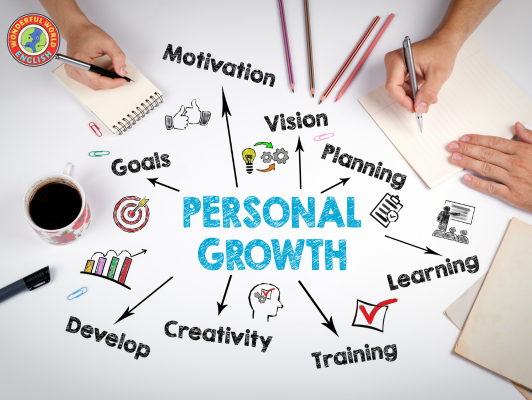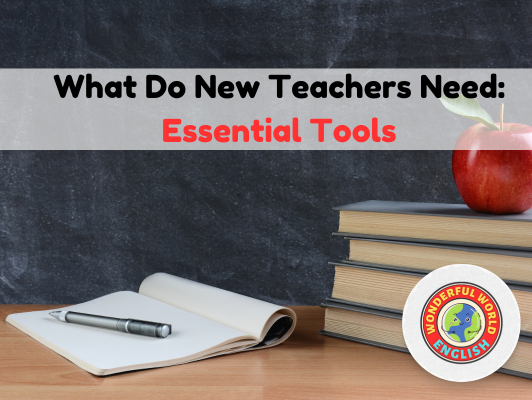
Meet David De’ Ath, founder, editor, and writer at Wonderful World English. With his extensive background as an English teacher, David provides valuable insights and practical tips on ESL for students and teachers alike.
The first year of teaching is both exhilarating and challenging.
New teachers find themselves having to navigate the intricate landscape of the educational environment, curriculum demands, and the diverse needs of their students.
Equipped with knowledge and enthusiasm, they must also cultivate a toolkit for effective classroom management, while fostering an environment that encourages student growth and learning.
To thrive in this demanding but rewarding profession, a new teacher must focus on establishing strong relationships with students, colleagues, and the community.
It is these relationships that form the cornerstone of a productive learning atmosphere and personal job satisfaction.
Continued professional development is equally critical, as it enables educators to remain not only informed about the latest teaching strategies and educational technology but also adaptable and resilient in the face of new challenges.
Key Takeaways
- Effective classroom management is crucial for a successful teaching environment.
- Strong interpersonal relationships greatly enhance the educational experience.
- Ongoing professional development is essential for teacher adaptability and resilience.
Preparing for the Classroom
In readiness for their roles, it is crucial for new teachers to equip themselves with strong classroom management skills and to develop robust lesson plans that cater to diverse learning needs.
Essential Classroom Management Skills
Effective classroom management starts with establishing clear routines and expectations from the beginning.
New educators should focus on creating a structured environment where students are aware of what is expected of them.
This might include:
- Rules and Procedures: Clearly defined rules and procedures help maintain order and ensure that students know how to behave. This sets the foundation for a productive learning environment.
- Consistency: Being consistent in implementing classroom rules is vital. It fosters trust and respect between students and the teacher.
- Positive Reinforcement: Encouraging positive behaviors through reinforcement can lead to a more engaging and cooperative classroom.
Developing Effective Lesson Plans
A well-crafted lesson plan is the blueprint for successful teaching and learning. Lesson plans should include:
- Learning Objectives: Objectives should be specific, measurable, attainable, relevant, and time-bound (SMART).
- Materials and Equipment: A detailed list of all materials needed for the lesson ensures the teacher is prepared and the class runs smoothly.
- Activities and Timing: Outlining activities and assigning time slots for each keeps the lesson on track.
- Assessment: A plan for assessing students’ understanding helps in modifying future lesson plans to suit the classroom’s needs.
- Homework Assignments: If homework is part of the plan, it should reinforce the day’s learning objectives and be manageable for students to complete independently.
By mastering these aspects, new teachers can better organize their classrooms and enhance their students’ educational experiences.
Essential Items
As a new teacher, preparing your classroom with the right tools and supplies is crucial for creating an effective and welcoming learning environment.
From the basic essentials to technology aids, each item plays a significant role in enhancing both teaching and learning experiences.
To help you get started, we’ve compiled a comprehensive list of physical items that are indispensable in any classroom setting:
| Category | Essential Items | Description |
|---|---|---|
| Basic Supplies | Whiteboard and Markers | Essential for visual demonstrations and teaching. |
| Notebooks and Pens/Pencils | For note-taking and assignments. | |
| Binder Clips and Paper Clips | To organize papers and documents. | |
| Sticky Notes | For reminders, bookmarks, or quick annotations. | |
| Technology | Laptop or Tablet | For accessing educational resources and managing digital content. |
| Printer and Scanner | For preparing handouts and scanning documents. | |
| Projector or Smart Board | To display multimedia resources to enhance learning. | |
| Classroom Resources | Educational Posters | Visual aids to support key concepts in subjects taught. |
| Clock | Helps manage class time effectively. | |
| Bulletin Board | For displaying educational materials, announcements, and student work. | |
| Learning Aids | Manipulatives (e.g., blocks, shapes) | Tools for hands-on learning, especially in subjects like math. |
| Flashcards | For drilling key concepts in various subjects. | |
| Reading Materials | Books and magazines appropriate for the age and skill level of the students. | |
| Organization | Storage Bins and Shelving | To keep supplies organized and accessible. |
| Label Maker | For labeling bins, shelves, and student work areas. | |
| Comfort Items | Cushions or Soft Seating | Comfortable seating options for reading or group discussions. |
| Plants | To improve classroom ambiance and air quality. | |
| Safety and Health | First Aid Kit | For dealing with minor injuries or emergencies. |
| Hand Sanitizer and Cleaning Wipes | To maintain cleanliness and hygiene within the classroom. |
Building Relationships
Effective relationship-building is vital for new teachers, as it creates a foundation of trust and support within the school community.
It encompasses establishing connections with students, engaging with parents and families, and collaborating with colleagues and mentors.
Building Student Connections
New teachers should prioritize creating a positive rapport with their students.
Tactics such as organizing morning meetings can set the tone for the day, allowing students to feel valued and heard.
Employing empathic listening helps in understanding student needs, and fostering an environment where students are more engaged, socially adept, and exhibit positive behavior.
Engaging with Parents and Families
Parents play a critical role in their children’s education, and fostering a collaborative relationship with them is beneficial.
Teachers can create regular communication channels through newsletters, emails, or parent-teacher meetings, thus keeping the community informed and involved.
This transparency builds trust and shows the family that the teacher is committed to the support and success of their child.
Collaborating with Colleagues and Mentors
Teacher-to-teacher relationships are just as crucial as those with students or parents.
Networking with peers and seeking mentors within the school can provide new teachers with much-needed guidance and resources.
Discussions with colleagues about best practices, classroom management, and curriculum development are vital for growth and professional development.

Professional Growth and Development
For new teachers, professional growth is not just beneficial, it is essential.
Emphasizing professional development and growth through education and feedback can lead to more effective teaching and profound impacts on student learning.
Embracing Continuing Education
Continuing education is a cornerstone of a teacher’s professional growth.
It ensures that educators remain knowledgeable about the latest educational research and teaching methodologies.
Teachers can engage in a variety of professional learning opportunities, such as workshops, seminars, and courses provided by Education Week.
Through these programs, they can learn about new technology tools for the classroom, gain insights into student culture, and further develop their instructional abilities.
- Learning Communities: Joining learning communities allows teachers to collaborate with peers, share experiences, and refine their practices based on collective knowledge.
- Leadership Opportunities: Actively seeking roles in educational leadership can provide invaluable experience that contributes to professional development.
Seeking and Implementing Feedback
Feedback is a powerful tool for professional development.
New teachers should seek constructive feedback from various sources, including mentors, peers, and their students.
The National Education Association highlights the importance of utilizing feedback to create transformation in teaching practices.
- Mentorship: Regular interaction with a mentor can provide personalized insights and guidance for continuous improvement.
- Self-Assessment: Reflecting on one’s own teaching is essential for recognizing areas for growth.
By integrating feedback into their teaching, educators are able to make informed changes to their instructional strategies, ultimately enhancing their professional growth.
Related: First-Year Teacher Advice: Thriving in Your New Classroom

Challenges and Supports
New teachers face several challenges during their initial year, which can lead to stress and even burnout if not properly supported.
To mitigate this, it is crucial for teachers to access resources and leverage support networks designed to assist them in navigating these challenges.
Addressing Common First-Year Hurdles
Stress and burnout are prevalent hurdles for new educators, who often grapple with a significant change in workload and responsibilities.
Effective support looks like strategic professional development and mentoring to address these issues.
For example, according to Edutopia, engaging in professional book studies can generate enthusiasm and constructive dialogue, which supports new teacher support systems.
Additionally, Education Week emphasizes that the foundation starts as early as the job interview, where school leaders can set the stage for ongoing support.
Related: Books on Classroom Management: Essential Picks
Utilizing Resources and Support Networks
- Support Networks: New teachers should be encouraged to connect with peer networks. These networks can reduce feelings of isolation and provide a platform for sharing experiences and solutions.
- Administrators and school leaders play a pivotal role in the success of new educators by fostering a culture of empowerment and inclusivity.
Resources like instructional coaches or established teaching frameworks can be instrumental.
For instance, Harvard Graduate School of Education discusses the importance of addressing challenges faced by teachers of color.
They suggest that school leaders may want to consider ways to support and retain these educators specifically.
You can join the Wonderful World English LinkedIn page to connect with thousands of other educators, which can be extremely valuable when first starting out in teaching.

Conclusion
Starting a teaching career can be a transformative journey filled with opportunities for growth and challenges.
For new teachers, it is essential to be well-equipped with the right tools and strategies to navigate the classroom effectively.
Effective classroom management, solid lesson plans, and building strong relationships with students and colleagues are foundational to a successful teaching experience.
Moreover, embracing continuous professional development and seeking feedback is crucial for ongoing improvement and job satisfaction.
By focusing on these areas, new teachers can create a supportive and effective learning environment that not only enhances student outcomes but also fosters personal and professional fulfillment in their teaching careers.
We hope you find value in this information. You can contact us if you are in need of any assistance.
Have a wonderful day!
Image Attribution: All images licensed via canva.com

